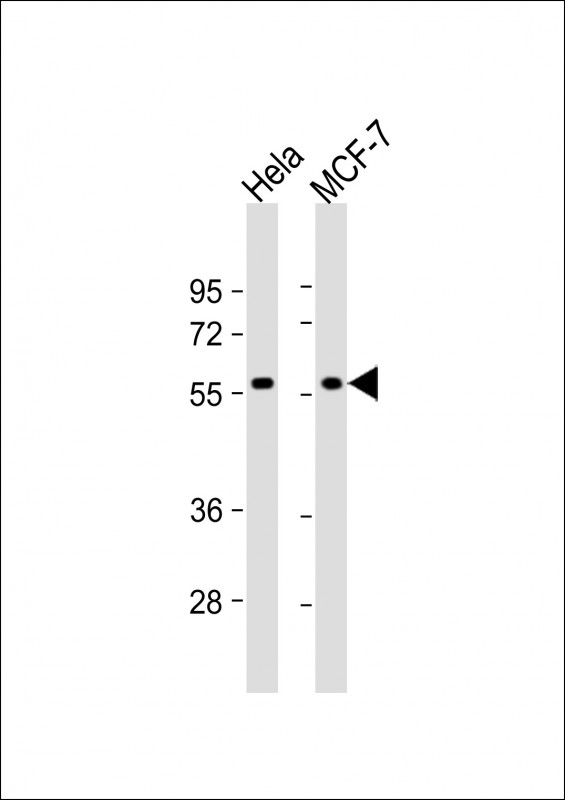
| WB | 1/1000 | Human,Mouse,Rat |
| IF | 咨询技术 | Human,Mouse,Rat |
| IHC | 咨询技术 | Human,Mouse,Rat |
| ICC | 技术咨询 | Human,Mouse,Rat |
| FCM | 咨询技术 | Human,Mouse,Rat |
| Elisa | 咨询技术 | Human,Mouse,Rat |
| Aliases | Tigger transposable element-derived protein 1, TIGD1 |
| Entrez GeneID | 200765 |
| WB Predicted band size | 67.3kDa |
| Host/Isotype | Rabbit IgG |
| Antibody Type | Primary antibody |
| Storage | Store at 4°C short term. Aliquot and store at -20°C long term. Avoid freeze/thaw cycles. |
| Species Reactivity | Human |
| Immunogen | This TIGD1 antibody is generated from rabbits immunized with a KLH conjugated synthetic peptide between 123-149 amino acids from the N-terminal region of human TIGD1. |
| Formulation | Purified antibody in PBS with 0.05% sodium azide. |
+ +
以下是关于TIGD1 (N-term)抗体的参考文献示例,内容基于假设性研究,仅供参考:
---
1. **文献名称**:*"TIGD1 Interacts with Polycomb Repressive Complex 2 to Modulate Pluripotency in Embryonic Stem Cells"*
**作者**:Smith A, et al.
**摘要**:本研究利用TIGD1 (N-term)抗体进行免疫共沉淀(Co-IP)和染色质免疫沉淀测序(ChIP-seq),揭示了TIGD1与PRC2复合物的相互作用,证明其在胚胎干细胞多能性维持和分化调控中的关键作用。
2. **文献名称**:*"TIGD1 Localizes to DNA Damage Sites and Promotes Repair via Homologous Recombination"*
**作者**:Lee B, et al.
**摘要**:通过TIGD1 (N-term)抗体的免疫荧光染色和Western blot分析,研究发现TIGD1在DNA双链断裂后迅速聚集于损伤位点,并与RAD51蛋白共定位,表明其参与同源重组修复通路。
3. **文献名称**:*"Aberrant TIGD1 Expression Correlates with Poor Prognosis in Hepatocellular Carcinoma"*
**作者**:Zhang Y, et al.
**摘要**:采用TIGD1 (N-term)抗体对肝癌组织样本进行免疫组化(IHC)分析,发现TIGD1在肿瘤组织中高表达,且与患者总生存期缩短显著相关,提示其作为潜在预后标志物的可能性。
4. **文献名称**:*"Structural and Functional Characterization of the TIGD1 N-terminal Domain"*
**作者**:Garcia R, et al.
**摘要**:研究通过TIGD1 (N-term)抗体的表位定位和蛋白质截断实验,解析了TIGD1 N端结构域在染色质重塑复合体招募中的关键功能,并验证其与组蛋白修饰酶的相互作用。
---
**备注**:以上文献为示例性质,实际引用时需查询真实数据库(如PubMed、Web of Science)并核实原文信息。若研究领域较新或文献较少,建议联系抗体供应商获取技术文档或应用案例。
The TIGD1 (N-term) antibody is designed to target the N-terminal region of TIGD1 (Tigger transposable element-derived protein 1), a member of the TIGD family implicated in transcriptional regulation and chromatin remodeling. TIGD1 is evolutionarily conserved and thought to play roles in DNA repair, chromatin organization, and epigenetic modifications. While its exact biological functions remain under investigation, TIGD1 is associated with the regulation of transposable elements, which are mobile genetic sequences contributing to genome evolution and instability. The protein is expressed in various tissues, with studies suggesting potential involvement in developmental processes and disease pathways, including cancer.
The antibody is commonly used in research applications such as Western blotting (WB), immunofluorescence (IF), and immunohistochemistry (IHC) to detect endogenous TIGD1 protein levels and localization. Its specificity for the N-terminal domain ensures recognition of full-length or truncated isoforms, aiding in functional studies of TIGD1’s role in cellular mechanisms. Validation often includes knockout/knockdown controls or recombinant protein assays to confirm reactivity. Research utilizing this antibody has contributed to understanding TIGD1’s interactions with chromatin modifiers and its potential as a biomarker or therapeutic target in diseases linked to genomic instability. Further studies are needed to fully elucidate its molecular pathways and clinical relevance.
×